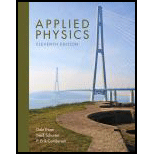
Applied Physics (11th Edition)
11th Edition
ISBN: 9780134159386
Author: Dale Ewen, Neill Schurter, Erik Gundersen
Publisher: PEARSON
expand_more
expand_more
format_list_bulleted
Textbook Question
Chapter 14.3, Problem 12P
Find the heat flow in 30 0 days through a freezer door 30.0in ×58 0in. insulated with cellulose fiber 2.0 in. thick. The temperature inside the freezer is -10–°F Room temperature is 72°F.
Expert Solution & Answer
Want to see the full answer?
Check out a sample textbook solution
Students have asked these similar questions
A granite ball of radius 3.00 m and emissivity 0.048 is heated to 120°C.
(c) If the ambient temperature is 25.0°C, what net power does the ball radiate?__________________W
A copper rod of radius 1.5 cm and length 0.8 m is used in stoking a fire which is at 415 oC. Find the rate of heat transfer (in W) if the room is at 20 oC.
Note the thermal conductivity of copper is 390 J/(s m °C).
How many joules of heat does 620 g of mercury require to go from a solid at -38.9 degrees celcius to vapor?
Chapter 14 Solutions
Applied Physics (11th Edition)
Ch. 14.1 - Find each temperature as indicated. 1. TF=77F,...Ch. 14.1 - Find each temperature as indicated. 2. TF=113F,...Ch. 14.1 - Find each temperature as indicated. 3. TF=257F,...Ch. 14.1 - Find each temperature as indicated. 4. TC=15C,...Ch. 14.1 - Find each temperature as indicated. 5. TC=145C,...Ch. 14.1 - Find each temperature as indicated. 6. TC=35C,...Ch. 14.1 - Prob. 7PCh. 14.1 - Prob. 8PCh. 14.1 - Find each temperature as indicated. 9. TC=95C,...Ch. 14.1 - Prob. 10P
Ch. 14.1 - Prob. 11PCh. 14.1 - Prob. 12PCh. 14.1 - Prob. 13PCh. 14.1 - Prob. 14PCh. 14.1 - Prob. 15PCh. 14.1 - Prob. 16PCh. 14.1 - Prob. 17PCh. 14.1 - The melting point of pure iron is 1505C. What...Ch. 14.1 - The melting point of mercury is -38.0F. What...Ch. 14.1 - A welding white heat is approximately 1400C. Find...Ch. 14.1 - The temperature in a crowded room is 85F. What is...Ch. 14.1 - The temperature of an iced tea drink is 5C. What...Ch. 14.1 - Prob. 23PCh. 14.1 - The melting point of ethyl alcohol is -179F. What...Ch. 14.1 - Prob. 25PCh. 14.1 - Prob. 26PCh. 14.1 - Prob. 27PCh. 14.1 - Prob. 28PCh. 14.1 - Prob. 29PCh. 14.1 - Prob. 30PCh. 14.1 - Prob. 31PCh. 14.2 - Find the amount of heat in cal generated by 95 J...Ch. 14.2 - Find the amount of heat in kcal generated by 7510...Ch. 14.2 - Find the amount of work that is equivalent to 1550...Ch. 14.2 - Find the amount of work that is equivalent to 3850...Ch. 14.2 - Find the mechanical work equivalent (in J) of 765...Ch. 14.2 - Find the mechanical work equivalent (in J) of 8550...Ch. 14.2 - Find the heat equivalent (in Btu) of 3.46106 ft lb...Ch. 14.2 - Prob. 8PCh. 14.2 - How much work must a person do to offset eating a...Ch. 14.2 - Prob. 10PCh. 14.2 - A fuel yields 1.15104 cal/g when burned. How many...Ch. 14.2 - A racing fuel produces 1.60104 cal/g when burned....Ch. 14.2 - Prob. 13PCh. 14.2 - A coal sample yields 1 25104 Btu/lb. How many foot...Ch. 14.2 - Prob. 15PCh. 14.2 - Find the amount of heat energy that must be...Ch. 14.2 - What is the mechanical work equivalent in 50,000...Ch. 14.2 - An industrial engine produces 38,000 kcal of heat....Ch. 14.3 - Find the R value of a pane of 0.125-in.-thick...Ch. 14.3 - Find the R value of a brick wall 4.0 in. thick.Ch. 14.3 - Find the R value of 0.50-in -thick sheetrock.Ch. 14.3 - Find the thermal conductivity of a piece of...Ch. 14.3 - Find the R value of 0.50-in.-thick corkboard.Ch. 14.3 - The dimensions of a rectangular building are...Ch. 14.3 - Find the heat flow during 30.0 days through a...Ch. 14.3 - Find the heat flow in 30.0 days through a...Ch. 14.3 - Find the heat flow in 75 s through a steel rod of...Ch. 14.3 - Find the heat flow in 15 min through a...Ch. 14.3 - Find the heat flow in 24 h through a refrigerator...Ch. 14.3 - Find the heat flow in 30 0 days through a freezer...Ch. 14.3 - Find the heat flow in 24 h through a refrigerator...Ch. 14.3 - Find the heat flow in 30 0 days through a freezer...Ch. 14.3 - Find the heat flow through the sides of an...Ch. 14.4 - Find Q for each material. 1. Steel, w=3.00 lb,...Ch. 14.4 - Find Q for each material. 2. Copper, m=155 kg,...Ch. 14.4 - Prob. 3PCh. 14.4 - Prob. 4PCh. 14.4 - Prob. 5PCh. 14.4 - Prob. 6PCh. 14.4 - Prob. 7PCh. 14.4 - Find Q for each material. 8. Brass, m=750 kg,...Ch. 14.4 - Find Q for each material. 9. Steel m=1250 g,...Ch. 14.4 - Prob. 10PCh. 14.4 - Find Q for each material 11. Water, m =800 g,...Ch. 14.4 - Prob. 12PCh. 14.4 - How many Btu of heat must be added to 1200 lb of...Ch. 14.4 - How many Btu of heat are given off by 500 lb of...Ch. 14.4 - How many kcal of heat must be added to 1250 kg of...Ch. 14.4 - How many joules of heat are absorbed by an...Ch. 14.4 - How many joules of heat are required to raise the...Ch. 14.4 - Prob. 18PCh. 14.4 - How many joules of heat are given off when 125 kg...Ch. 14.4 - A 525-kg steam boiler is made of steel and...Ch. 14.4 - Find the initial temperature of a 49.0-N cube of...Ch. 14.4 - Prob. 22PCh. 14.4 - A block of iron with mass 0.400 kg is heated to...Ch. 14.4 - A block of copper is heated from 20.0C to 80.0C....Ch. 14.4 - The cooling system of a truck engine contains 20.0...Ch. 14.5 - A 2.50-lb piece of steel is dropped into 11.0 lb...Ch. 14.5 - Prob. 2PCh. 14.5 - A 250 g piece of tin at 99C is dropped in 100 g of...Ch. 14.5 - How many grams of water at 20C are necessary to...Ch. 14.5 - A 159-lb piece of aluminum at 500F is dropped into...Ch. 14.5 - Prob. 6PCh. 14.5 - If 1250 g of copper at 20.0C is mixed with 500 g...Ch. 14.5 - If 500 g of brass at 200C and 300 g of steel at...Ch. 14.5 - The following data were collected in the...Ch. 14.5 - The following data were collected in the...Ch. 14.5 - Prob. 11PCh. 14.5 - How much heat must be absorbed by its surroundings...Ch. 14.5 - How much water at 0C would be needed to cool the...Ch. 14.5 - Prob. 14PCh. 14.6 - Find the increase in length of copper tubing 200.0...Ch. 14.6 - Find the increase in length of a zinc rod 50.0 m...Ch. 14.6 - Find the increase in length of 300.00 m of copper...Ch. 14.6 - A steel pipe 8.25 m long is installed at 45C. Find...Ch. 14.6 - A steel tape measures 200.00 m at 15C. What is its...Ch. 14.6 - A brass rod 1.020 m long expands 3.0 mm when it is...Ch. 14.6 - The road bed on a bridge 500.0 ft long is made of...Ch. 14.6 - An aluminum plug has a diameter of 10.003 cm at...Ch. 14.6 - The diameter of a steel drill at 45F is 0.750 in....Ch. 14.6 - A brass ball with diameter 12.000 cm is 0.011 cm...Ch. 14.6 - A brass cylinder has a cross-sectional area of 482...Ch. 14.6 - The volume of the cylinder in Problem 11 is 4820...Ch. 14.6 - An aluminum pipe has a cross-sectional area of...Ch. 14.6 - A steel pipe has a cross-sectional area of 127.20...Ch. 14.6 - A glass plug has a volume of 60.00 cm3 at 12C....Ch. 14.6 - The diameter of a hole drilled through brass at...Ch. 14.6 - Prob. 17PCh. 14.6 - Steel beams 60.000 ft long are placed in a highway...Ch. 14.6 - The spaces between 13.00-m steel rails are 0.711...Ch. 14.6 - A section of concrete dam is a rectangular solid...Ch. 14.6 - A glass ball has a radius of 12.000 cm at 6.0C....Ch. 14.6 - Find the final height of a concrete column that is...Ch. 14.6 - What is the final volume of a glass right circular...Ch. 14.6 - A metal bar at 21.0C is 2.6000 m long. If the bar...Ch. 14.7 - A quantity of carbon tetrachloride occupies 625 L...Ch. 14.7 - Some mercury occupies 157 in3 at -30F. What is its...Ch. 14.7 - Some petroleum occupies 11.7 m3 at -17C. Find its...Ch. 14.7 - Find the increase in volume of 35 L of acetone...Ch. 14.7 - Some water at 180F occupies 3780 ft 3 What is its...Ch. 14.7 - A 1200-L tank of petroleum is completely filled at...Ch. 14.7 - Find the increase in volume of 215 cm3 of mercury...Ch. 14.7 - Find the decrease in volume of 2000 ft 3 of...Ch. 14.7 - Prob. 9PCh. 14.7 - Prob. 10PCh. 14.7 - What was the temperature of 180 mL of acetone...Ch. 14.7 - What is the increase in volume of 1200 L of...Ch. 14.7 - Five hundred litres of petroleum at 4.0C is heated...Ch. 14.8 - Prob. 1PCh. 14.8 - Prob. 2PCh. 14.8 - Prob. 3PCh. 14.8 - Prob. 4PCh. 14.8 - How many calories of heat are required to melt 320...Ch. 14.8 - How many calories of heat are given off when 3250...Ch. 14.8 - How many joules of heat are required to melt 20.0...Ch. 14.8 - How many kilocalories of heat are required to melt...Ch. 14.8 - How many joules of heat need to be removed to...Ch. 14.8 - How many litres of water at 100C are vaporized by...Ch. 14.8 - Prob. 11PCh. 14.8 - How many Btu of heat are released when 20.0 lb of...Ch. 14.8 - How many Btu of heat are required to change 9.00...Ch. 14.8 - How many calories of heat are released when 200 g...Ch. 14.8 - How many kilocalories of heat are required to melt...Ch. 14.8 - How many joules of heat are required to melt 15.0...Ch. 14.8 - Prob. 17PCh. 14.8 - How many kcal of heat are needed to vaporize 5.00...Ch. 14.8 - Prob. 19PCh. 14.8 - Prob. 20PCh. 14.8 - How many kilocalories of heat are needed to change...Ch. 14.8 - How many joules of heat does 620 g of mercury...Ch. 14 - Which of the following are methods of heat...Ch. 14 - Which of the following are good conductors of...Ch. 14 - The amount that a solid expands when heated...Ch. 14 - Prob. 4RQCh. 14 - Prob. 5RQCh. 14 - Prob. 6RQCh. 14 - In your own words, describe the method of...Ch. 14 - Prob. 8RQCh. 14 - Which other temperature scale is closely related...Ch. 14 - Which other temperature scale is closely related...Ch. 14 - Distinguish between the Celsius and Fahrenheit...Ch. 14 - Distinguish between heat and temperature.Ch. 14 - Give three examples of the conversion of heat into...Ch. 14 - Give three examples of the conversion of work into...Ch. 14 - Should you wear light- or dark-colored clothing on...Ch. 14 - Does the area of a hole cut out of a metal block...Ch. 14 - Which would cool a hot object better: 10 kg of...Ch. 14 - Steam can cause much more severe burns than hot...Ch. 14 - Why are ice cubes often observed to have a slight...Ch. 14 - In your own words, describe each method of heat...Ch. 14 - Describe why automotive cooling systems are...Ch. 14 - Change 344 K to degrees Celsius.Ch. 14 - Change 24C to Kelvin.Ch. 14 - Prob. 3RPCh. 14 - Change 635F to degrees Celsius.Ch. 14 - Prob. 5RPCh. 14 - Find the amount of heat in kcal generated by 6530...Ch. 14 - Find the amount of work equivalent to 435 Btu.Ch. 14 - Find the heat flow during 4.10 h through a glass...Ch. 14 - Find the heat flow in 25.0 days through a freezer...Ch. 14 - How many Btu of heat must be added to 835 lb of...Ch. 14 - How many kcal of heat must be added to 148 kg of...Ch. 14 - A 161-kg steam boiler is made of steel and...Ch. 14 - A 3.80-lb piece of copper is dropped into 8.35 lb...Ch. 14 - Prob. 14RPCh. 14 - Prob. 15RPCh. 14 - The length of a steel rod at 5C is 12.500 m. What...Ch. 14 - The diameter of a hole drilled through aluminum at...Ch. 14 - A steel ball has a radius of 1.54 cm at 35C. Find...Ch. 14 - Find the increase in volume of 44.8 L of acetone...Ch. 14 - What is the decrease in volume of 3450 ft3 of...Ch. 14 - How many kcal of heat are required to vaporize...Ch. 14 - How many Btu of heat are required to melt 8.35 lb...Ch. 14 - How many kcal of heat must be withdrawn from 4.56...Ch. 14 - How many joules of heat are required to change 336...Ch. 14 - A polystyrene foam cover prevents an ice-water...Ch. 14 - Every winter a local recreation department fills a...Ch. 14 - Prob. 3ACCh. 14 - Pedro, a contractor, is trying to choose between...Ch. 14 - In anticipation of winter snowstorms, Jamal fills...
Additional Science Textbook Solutions
Find more solutions based on key concepts
Q1.14 Air traffic controllers give instructions called “vectors” to tell airline pilots in which direction they...
University Physics (14th Edition)
The acceleration during interval A, the acceleration during interval B and the acceleration during interval C.
College Physics: A Strategic Approach (3rd Edition)
Explain all answers clearly, with complete sentences and proper essay structure if needed. An asterisk (*) desi...
Cosmic Perspective Fundamentals
An elevator suspended by a cable is descending at constant velocity. How many force vector would be shown on ...
Physics for Scientists and Engineers: A Strategic Approach with Modern Physics (4th Edition)
Calculate the work done when a force of 2 N moves a book 3 m.
Conceptual Integrated Science
Knowledge Booster
Learn more about
Need a deep-dive on the concept behind this application? Look no further. Learn more about this topic, physics and related others by exploring similar questions and additional content below.Similar questions
- A steel ball (200mm in diameter) was heated to around 10000d C and was placed inside a vacuum chamber. What is the rate of heat transfer, in watts through radiation from the ball to the surrounding area?use "K=73+ d C" let the emissivity be equal to 0.32 (3 decimal places)arrow_forwardA glass window 0.33 cm thick measures 81 cm by 39 cm. Howmuch heat flows through this window per minute if the inside andoutside temperatures differ by 13 C°?arrow_forwardWhat is the rate of heat transfer by radiation of an unclothed person standing in a dark room whose ambient temperature is 22.0 °C?arrow_forward
- Find the emissivity of a man whose skin has area of 1.7 m2 subjected of intense solar radiation incident at a 60° angle and receives heat rate at 294 Cal/hr.arrow_forwardIt takes 880 J to raise the temperature of 350 g of lead from 0°C to 20.0°C. What is the specific heat of lead?arrow_forwardThe filament of a 75-W light bulb is at a temperature of 3,700 K. Assuming the filament has an emissivity e = 0.9, find its surface area. m2arrow_forward
- (I) How much heat (in joules) is required to raise thetemperature of 34.0 kg of water from 15°C to 95°C?arrow_forwardA 250.0 mL Pyrex glass container is filled with gasoline at 50.0°C. How much gasoline is needed to fill the container again if it is cooled to 35°C?arrow_forward5. A copper slab of length 15.0cm and cross-section area 105cm2 has Th=125degree Celsius and Tc=10degree Celsius. How much heat is conducted through the slab in 30sec.? Copper has a thermal conductivity of 401W/m.K.arrow_forward
- Find the heat flow in 30.0 days through a 0.25 cm thick steel plate with cross section 45 cm X 75 cm. Assume a temperature differential of 95 degrees celcius.arrow_forward(I) What is the specific heat of a metal substance if 135 kJof heat is needed to raise 4.1 kg of the metal from 18.0°C to37.2°C?arrow_forwardA 50.0g thermometer is used to measure the temperature of 100 mL of water. The specific heat of the thermometer, which is mostly glass, is 750J/(kgK), and it reads 23.0 ∘C while lying on the table. After being completely immersed in the water, the thermometer's reading stabilizes at 77.8 ∘C. What was the actual water temperature before it was measured?arrow_forward
arrow_back_ios
SEE MORE QUESTIONS
arrow_forward_ios
Recommended textbooks for you
 College PhysicsPhysicsISBN:9781305952300Author:Raymond A. Serway, Chris VuillePublisher:Cengage Learning
College PhysicsPhysicsISBN:9781305952300Author:Raymond A. Serway, Chris VuillePublisher:Cengage Learning University Physics (14th Edition)PhysicsISBN:9780133969290Author:Hugh D. Young, Roger A. FreedmanPublisher:PEARSON
University Physics (14th Edition)PhysicsISBN:9780133969290Author:Hugh D. Young, Roger A. FreedmanPublisher:PEARSON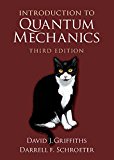 Introduction To Quantum MechanicsPhysicsISBN:9781107189638Author:Griffiths, David J., Schroeter, Darrell F.Publisher:Cambridge University Press
Introduction To Quantum MechanicsPhysicsISBN:9781107189638Author:Griffiths, David J., Schroeter, Darrell F.Publisher:Cambridge University Press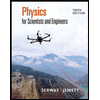 Physics for Scientists and EngineersPhysicsISBN:9781337553278Author:Raymond A. Serway, John W. JewettPublisher:Cengage Learning
Physics for Scientists and EngineersPhysicsISBN:9781337553278Author:Raymond A. Serway, John W. JewettPublisher:Cengage Learning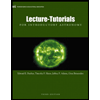 Lecture- Tutorials for Introductory AstronomyPhysicsISBN:9780321820464Author:Edward E. Prather, Tim P. Slater, Jeff P. Adams, Gina BrissendenPublisher:Addison-Wesley
Lecture- Tutorials for Introductory AstronomyPhysicsISBN:9780321820464Author:Edward E. Prather, Tim P. Slater, Jeff P. Adams, Gina BrissendenPublisher:Addison-Wesley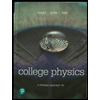 College Physics: A Strategic Approach (4th Editio...PhysicsISBN:9780134609034Author:Randall D. Knight (Professor Emeritus), Brian Jones, Stuart FieldPublisher:PEARSON
College Physics: A Strategic Approach (4th Editio...PhysicsISBN:9780134609034Author:Randall D. Knight (Professor Emeritus), Brian Jones, Stuart FieldPublisher:PEARSON

College Physics
Physics
ISBN:9781305952300
Author:Raymond A. Serway, Chris Vuille
Publisher:Cengage Learning

University Physics (14th Edition)
Physics
ISBN:9780133969290
Author:Hugh D. Young, Roger A. Freedman
Publisher:PEARSON

Introduction To Quantum Mechanics
Physics
ISBN:9781107189638
Author:Griffiths, David J., Schroeter, Darrell F.
Publisher:Cambridge University Press

Physics for Scientists and Engineers
Physics
ISBN:9781337553278
Author:Raymond A. Serway, John W. Jewett
Publisher:Cengage Learning

Lecture- Tutorials for Introductory Astronomy
Physics
ISBN:9780321820464
Author:Edward E. Prather, Tim P. Slater, Jeff P. Adams, Gina Brissenden
Publisher:Addison-Wesley

College Physics: A Strategic Approach (4th Editio...
Physics
ISBN:9780134609034
Author:Randall D. Knight (Professor Emeritus), Brian Jones, Stuart Field
Publisher:PEARSON
Thermal Expansion and Contraction of Solids, Liquids and Gases; Author: Knowledge Platform;https://www.youtube.com/watch?v=9UtfegG4DU8;License: Standard YouTube License, CC-BY